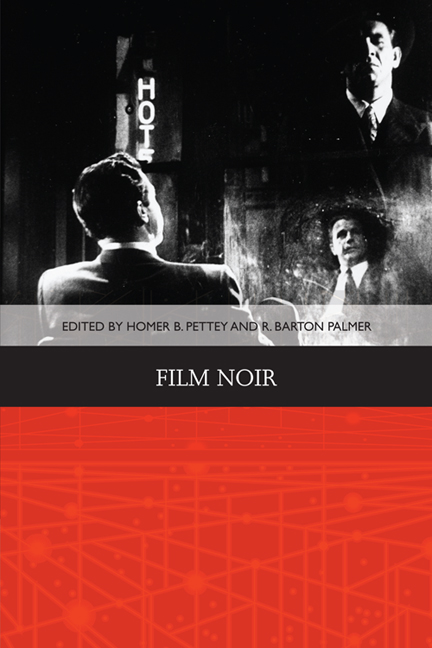Book contents
- Frontmatter
- Contents
- List of Illustrations
- Acknowledgements
- Notes on the Contributors
- Introduction: The Noir Turn
- 1 The Cinema of Uncertainty and the Opacity of Information from Louis Feuillade's Crime Serials to Film Noir
- 2 Warning Shadows: German Expressionism and American Film Noir
- 3 Hard-boiled Tradition and Early Film Noir
- 4 Cold War Noir
- 5 Noiring the Pitch: The Conflicted Soundtracks of Out of the Past, The Blue Gardenia and The Long Goodbye
- 6 Split Screen: Sound/Music in The Stranger/Criss Cross
- 7 Gender and Noir
- 8 The Subversive Shade of Black in Film Noir
- Postscript: A History of Our Writing about Film Noir
- Selected Book Chapters on Film Noir
- Selected Film Noir Books
- Selected Guide to Film Noir
- Index
8 - The Subversive Shade of Black in Film Noir
Published online by Cambridge University Press: 05 August 2016
- Frontmatter
- Contents
- List of Illustrations
- Acknowledgements
- Notes on the Contributors
- Introduction: The Noir Turn
- 1 The Cinema of Uncertainty and the Opacity of Information from Louis Feuillade's Crime Serials to Film Noir
- 2 Warning Shadows: German Expressionism and American Film Noir
- 3 Hard-boiled Tradition and Early Film Noir
- 4 Cold War Noir
- 5 Noiring the Pitch: The Conflicted Soundtracks of Out of the Past, The Blue Gardenia and The Long Goodbye
- 6 Split Screen: Sound/Music in The Stranger/Criss Cross
- 7 Gender and Noir
- 8 The Subversive Shade of Black in Film Noir
- Postscript: A History of Our Writing about Film Noir
- Selected Book Chapters on Film Noir
- Selected Film Noir Books
- Selected Guide to Film Noir
- Index
Summary
In the American context, there being no way for him to get to the nigger, he [Fritz Lang] could use only that other American prototype, the criminal, le gangster.
James Baldwin, ‘The devil finds work’Just how subversive was film noir? For Paul Schrader the answer is obvious: the anxiety after World War II over the Bomb, the war's disruption to middleclass domesticity and the Red Menace resulted in films that ‘took a harsh uncomplimentary look at American life’. Even before the end of World War II films like John Huston's The Maltese Falcon (1941) and Billy Wilder's Double Indemnity (1944) tied the unholy trinity of greed, lust and murder to the American Dream, turning a valorised myth upside down. Yet there is one segment of American society that film noir failed to analyse, according to its critics: the caste system that Gunner Myrdal called An American Dilemma (1944). Published a year before World War II ended and film noir (supposedly) began, his famous study investigated the ‘dark corner’ of American life. Myrdal ruthlessly exposed the contradiction within a social system whose America Creed said one thing, equality and justice for all, and whose practice towards African-Americans said another. Black life, he argued, remained at a standstill, bogged down at the bottom of the social system with no place to go. Although critics such as Eric Lott, Paula Rabinowitz, Julian Murphet, E. Ann Kaplan and Manthia Diawara have written brilliantly about film noir, they all agree, in their different ways, that film noir does not do what Myrdal did in his famous study. The directors of these films either recycled the same stereotypes from other genres, or they used the ‘Negro’ (male or female) as a negative foil to whiteness (Lott) or as a ‘fall from whiteness’ (Diawara). Kaplan suggests that the white femme fatale connects the ‘darkness of the psyche … with the literal darkness of racial others’, and Julian Murphet ingeniously associates her, in terms of the ‘racial unconscious’, with the frightening prospect of black masses flooding American cities after World War II. Rabinowitz perceptively sees Kathie Moffat's black maid in Out of the Past (1947) as her double but categorises that connection as ‘Kathie's aura – another type of literal femme noire’.
- Type
- Chapter
- Information
- Film Noir , pp. 164 - 181Publisher: Edinburgh University PressPrint publication year: 2014



